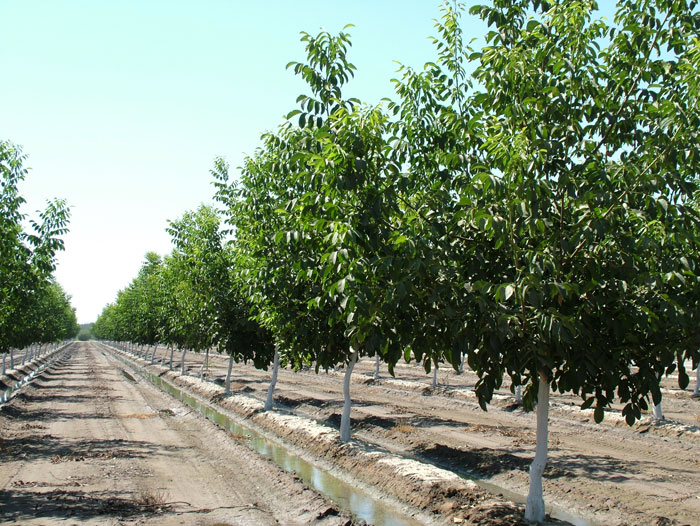
How double-sided sticky tape can help reduce Bot infections in your walnut orchard
Bot has become more prevalent in walnut orchards throughout California over the last several years. Meanwhile, during the past decade walnut growers in the Sacramento Valley have also been noticing more scale in their fields.

If you want to reduce Botryosphaeria canker and blight in your walnut trees, you might be money ahead to pick up a roll of doubled-sided sticky tape the next time you’re at the hardware store. By itself, the tape won’t stop advance of this fungal disease. But, it can help you keep an eye on walnut scale, which has been found to increase pressure from the disease, commonly called Bot.
Bot has become more prevalent in walnut orchards throughout California over the last several years. Meanwhile, during the past decade walnut growers in the Sacramento Valley have also been noticing more scale in their fields. In fact, two years ago, University of California plant pathologist Themis Michailides, with the UC Kearney Research and Extension Center, Parlier, Calif., confirmed that scale insects can increase Bot infection and canker development. That’s why UC Cooperative Extension recommendations for reducing Bot in orchards include controlling scale insects.
Walnut scale (Quadraspidiotus juglansregiae) is the most common of several scale species found in walnut orchards. Featuring an armored scale in which the cover is separate from the body, walnut scale sucks plant juices from the inner bark but rarely causes economic damage.
It is found in crusted layers on trunks, scaffolds and older branches in high populations and completes two generations per year. When mature, walnut scale develops in daisy-shaped groups as male crawlers, which form elongated covers, settling under the margin of the female cover.
Before dying, walnut scale females lay eggs underneath the protective cover. These eggs hatch into an immature insect known as a ‘crawler’ which is very small, yellow and mobile. The young crawlers move around the branches before selecting a new feeding location. After settling down, they secrete a protective waxy cover, remaining sedentary for the rest of their lives.
During winter, scale can be found on prunings and the trunk of the tree. Crawlers are usually active in May. That’s where the double-sided sticky tape can prove handy. To monitor crawler emergence in the first generation, researchers recommend applying the tape to limbs in April through June.
A second generation of crawlers is active in in late summer/early fall.
More information on walnut scale and management practices is available at www.ipm.ucdavis.edu
The UC IPM guidelines list biological approaches as one option for controlling walnut scale. They include two predators—the twicestabbed lady beetle, Chilocorus orbus, and another small beetle, Cybocephalus californicus —which often occur in numbers large enough to control low to moderate population levels of the walnut scale. But these predators may not provide timely control if scale populations are high. Two parasitic wasps, an Aphytis and an Encarsia species, also are prevalent on walnut orchards and help control this pest.
Biological control and sprays of narrow range oils can be used in an organically-certified crop.
Insecticides are another alternative.
Michailides, along with Janine Hasey, UCCE farm advisor for Colusa, Sutter and Yuba Counties and Bob Van Steenwyk, a UC Berkeley research entomologist, studied the effectiveness of six insecticides in controlling walnut scale in a field trial last. They describe their findings in the March, 2015, issue of Sacramento Valley Walnut News. Their article also includes results of 2014 research updates and fungicide trials to manage Bot canker and blight.
The insecticide trial involved a Yuba County orchard of Vina walnuts. To monitor walnut scale the researchers wrapped double-sided sticky tape on two limbs of each tree in their study on March 25, 2014, catching the first crawlers on April 23. They tested six insecticides using a total of nine different treatments.
Depending on the material, walnut scale sprays are applied either at delayed dormant (typically March) or after crawlers have emerged (typically May), the researchers said. In this trial, rain postponed the delayed dormant treatment until April 8, when the researchers applied the insect growth regulators (IGRs) Seize 35WP and Centaur 70. Treatments targeting crawlers were sprayed on May 6 at early crawler emergence. Sprays were applied using a hand held orchard sprayer at about 200 gallons per acre. The researchers counted the walnut scale crawlers on the sticky tape from May 5 to June 2 in a lab.
To determine possible delayed effects from the insecticides, they sampled lateral branch sections from each tree in January, 2015, for live overwintering second instar and adult female walnut scale.
Here’s a summary of their findings:
Spring/Early June, 2014, trials
Centaur 70WDG applied post delayed dormant provided excellent control. It had significantly lower walnut scale than all materials applied at crawler timing and lower scale than Seize 35WP, the standard delayed dormant material, which provided acceptable control.
Assail 30SG (high rate), Centaur 70WDG, and Brigadier 2EC applied at crawler timing provided acceptable control.
Assail 30WG at the low rate, Movento 2SC, and Sequoia 2SC were not significantly different from the untreated control.
January 2015 Follow-up:
Centaur 70WDG and Seize 35WP (delayed dormant application) and Movento 2SC, Centaur 70WDG, and Brigadier 2EC (crawler application) provided excellent long-term walnut scale control at eight months after application
Sequoia 2SC and Assail 30SG at the high and low rate were not significantly different from the untreated check.
About the Author(s)
You May Also Like



